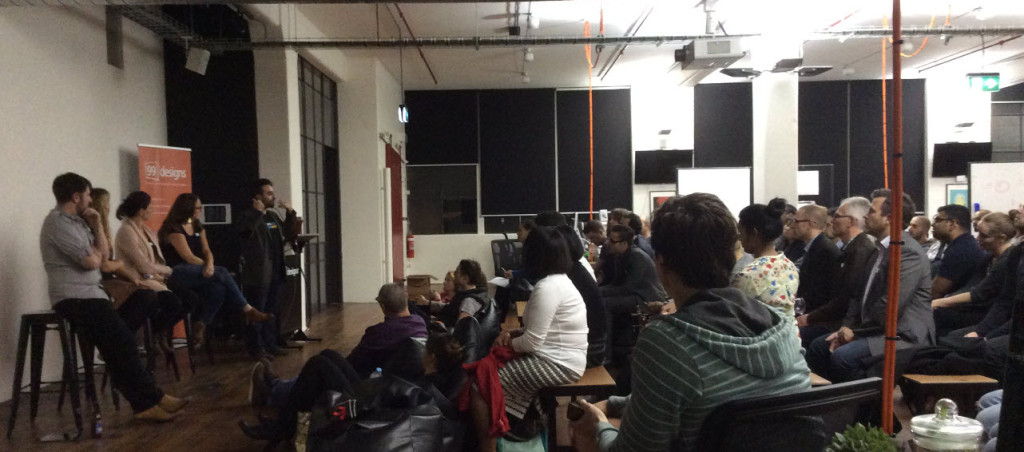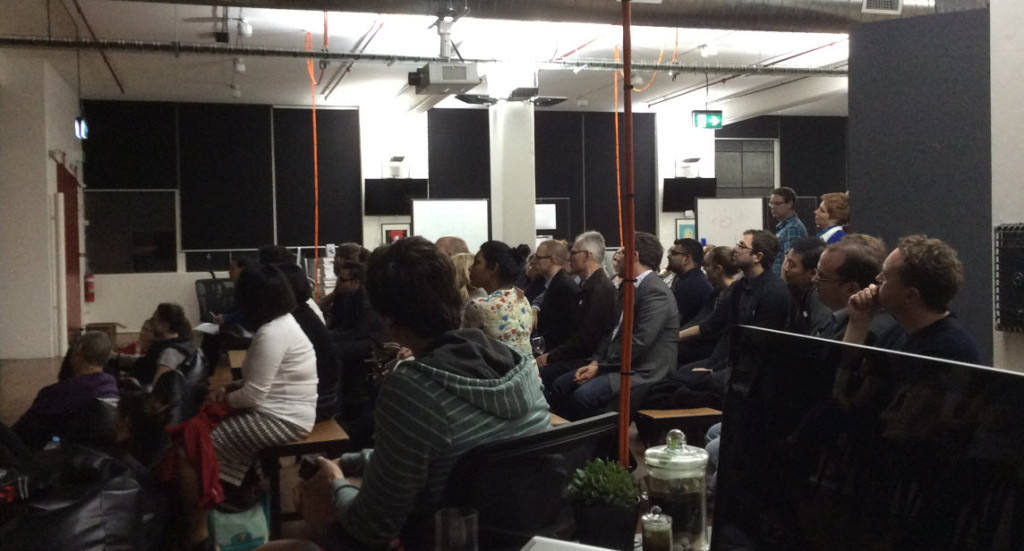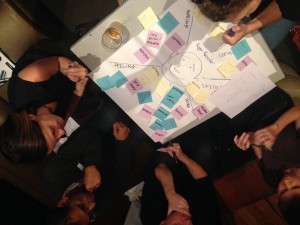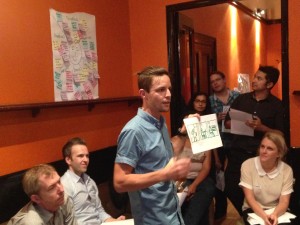Months ago we found out London’s Product People founder, Jock Busuttil, was headed to Australia and we were able to lure him to Melbourne (& Product Anon) with talk of good food and beverages. As Jock teaches ‘How to build a MVP Product‘ at General Assembly in London and we hadn’t talked about Minimum Viable Product at any of our sessions, we thought it was about time.
To join Jock, we assembled a panel of product managers from Seek (Emma Stabey), Geoplex (Janet Horwell) and 99designs (Susan Teschner) & a founder from Adioso (Tom Howard) to share their MVP success, failures and wisdom.
MVP has been popularised by Lean Startup & Eric Ries who advise building a minimum viable product in order to get feedback and start the build-measure-learn loop.
One of the difficulties of implementing MVP is making sure both minimum and viable are given consideration. Susan Teschner at 99designs talked of a recent experience where the team’s MVP was too minimum and not enough viable but with some changes they’re now seeing interest in the idea and will continue to test their hypothesis. Susan found this great quote illustrating the importance of ‘viable’:
“One of the temptations with the MVP approach is to build a bridge that only goes halfway across a ravine and then to ship it so you can get iterative feedback. The feedback amounts to ‘this bridge sucks’ even if a bridge across a ravine is a brilliant idea.” – Startup Blender
And just because the concept of MVP exists, it doesn’t mean it should be used all the time. Emma Stabey talked about some of the considerations in deciding if an MVP process is right for certain products. For Seek’s iPhone app, they knew customers already had certain expectations, experiences with competitor products and the demand was there. This wasn’t a product to go in with ‘minimum’ or needing to test ‘viable’.
Janet Horwell from Geoplex described a MVP situation where the team identified & understood a problem in their industry plus had it validated by customers – only to find the customer wasn’t prepared to pay for it. She shared some of their ‘how-to’ for working through the MVP including using both lean canvas and empathy maps to test the hypothesis and understand users. As you go through the build-measure-learn process, Janet recommended going back to both the canvas & maps or any data or industry trend metrics to review and assess whether you should continue to move forward. Taking learnings from their unsuccessful MVP, Janet and the team have successfully moved forward on another MVP which has a validated problem and paying customers.
Is one target audience’s MVP, the same as another? While Tom Howard of Adioso uses MVP concepts all the time, he is looking to expand beyond the early adoptors. One thing that guides him these days is getting people to care about the product and how they would feel if the product was no longer available. Perhaps this is where MVP becomes MDP (minimum delightful product)?
While most of us in the audience & everyone on the panel focuses on digital, MVP can be used anywhere. Jock talked about Virgin using MVP in 1984. Instead of going big launch & incurring the expense of multiple airplanes, staff, routes across a range of airports, Virgin tested. They leaded 1 plane which flew 1 route which allowed them to test the new concept in air travel.
Top Tips for doing MVP
We all love those little secrets to doing things better so we wanted to know the panel’s top tips for for doing MVP.
Janet spoke about the need of having the MVP concept accepted by the company and all your stakeholders including the CEO. For some people, MVP will be a new idea and they won’t understand the benefits or process. Make sure you educate those stakeholders by providing examples, case studies and showing the benefits. This is something your entire MVP-friendly team can help out with – it shouldn’t fall just on the product manager’s shoulders.
Emma’s top tip is to define what success looks like upfront including what data you need to make that call. I have certainly been in the situation when I thought google analytics were being collected and it turned out the event tracking wasn’t working so I’ll echo Emma’s suggestion & recommend confirmation of the data collection 😉 .
[pullquote] A landing page is not MVP – it’s an experiment. – Jock Busuttil [/pullquote]
If Tom was doing it all over again, he’d try to get a better understanding of what he was getting into since the crowded travel industry is hard (though he loves it!). He would also decide up front if the product should be commercialised right away or if it would focus on gaining users and worry about commercialisation later (ala Facebook & Twitter). That decision will influence what you put into your MVP.
Susan, who has worked at both start-ups and large organisations, talked about MVP being a double edged sword at large companies. The lure of MVP… getting something out there quickly for feedback and being able to iterate on it… can be strong but it can be hard to keep an iterative cycle going in large companies. Be careful that ‘MVP’ doesn’t become the new language for ‘phase 1’ – and we all know what happens beyond phase 1, don’t we?!
Questions
Next, we opened the floor to questions.
Dogfood.
The idea of ‘dog-fooding’ was raised and whether those on the panel ate their own dog food. Seek & 99designs dog-food their products. Adioso is so dog-food’d that Tom had only gotten back to Melbourne a few hours before our session.
But eating your own dog food isn’t always as straight forward as you might think. Jock reminded us that we and our team mates are not always the target market.
Janet had a great example of this as using their own product helped them discover a need – but when they got customers involved they found the feature was indeed wanted but customers weren’t prepared to pay extra for it.
Advice
When asked about what advice would you give yourself, both Emma & Susan went right to the customer – make sure there is an actual need for your product and that you understand the problem your product is trying to solve.
Making sure you have a common understanding of the measure of success amongst your team is the advice Janet would give herself. She had a start-up experience where the measure of success was very different across the team which lead to difficulties when defining an MVP. I think I saw some nodding heads across the crowd when Janet talked about the members of a team having different ideas.
Tom’s advice would be to keep going towards the goal – as long as you have validation – and Jock said to keep going as long as you’re learning and adjusting the product with those learnings.
Join us next time
Our next meetup is Thursday June 19th with Mat Vine leading the discussion on ‘Do stakeholders & customers ever see eye to eye?’. RSVP or read more…
Our Speakers
A huge thanks from Liz & myself to our speakers for sharing their MVP & product management experience!!
If you’d like to hear more from them, check out:
- Jock Busuttil from Product People ( @jockbu )
- Susan Teschner from 99designs
- Tom Howard from Adioso ( @tomhoward )
- Emma Stabey from Seek ( @emstabey )
- Janet Horwell from Geoplex ( @janhorwell )
And another huge thanks to our sponsors for the evening who provided the venue, beer and pizza!
- Brainmates Product Management Training & Expertise
- 99designs






